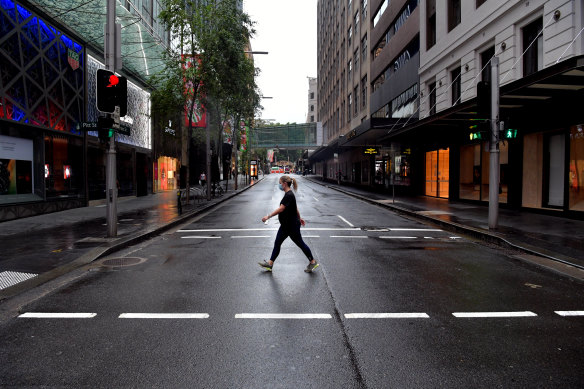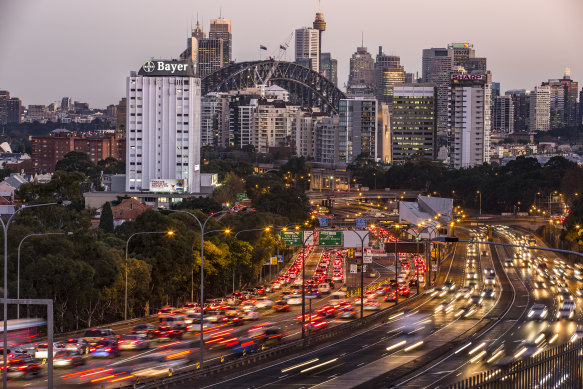This was published 2 years ago
Opinion
‘Seismic and exciting’: Sydney’s COVID-given chance to dump the CBD
Elizabeth Farrelly
Columnist, author, architecture critic and essayistI don’t agree with censorship, almost ever, yet one term in common usage I would happily ban: CBD. Central Business District. COVID forces us to question both the overwhelming centralism of Australian cities, and their ongoing dominance by business. But cracks were appearing well before that.
The term CBD is so familiar, so taken-for-granted in our daily lives, you’d think there was no alternative. Yet it’s quite a new idea. The idea that we define “city” as a towering, central business district linked by many-tentacled motorways to a vast puddle of single-home suburbia is a mere century old. In millennia of city-making, it’s a mere blip.

COVID-19 will accelerate the death of the CBD..Credit:
When it began, this American blip seemed excitingly progressive. But it is now clear that shaping our cities around the CBD-suburb concept will only tip us more quickly over the cliff.
The high-rise city centre and its low-rise skirt are, in many ways, opposites. Respectively tall and short, dense and rarefied, they also divide work from living, day from night, fast from slow and, conceptually, male from female.
The gender divide is fascinating. You might argue that, since women also work, a work-based CBD isn’t inherently sexist. At the time, though, it was expected that money making was serious men’s business, while child-making and home-making was women’s work.
This was articulated in the 19th century by William Wilberforce, who saw domiciled women as bait to draw men out of the sinful city at night. But it also plays to the modernist stereotype, articulated by DH Lawrence and others, of the Apollonian (rational, day lit) male and the Dionysian (mysterious, emotional) female, creature of the night.
Uses and genders are not the only things the modernist city separates. Buildings too. Just as the suburban bungalow is an object moated by space – hence “nuclear” family – so CBD towers were conceived as objects “in the round”. Sydney’s first true skyscraper, Seidler’s Australia Square (1964), was physically round. But even square towers, being glazed all round, are designed to float in space. CBD towers are bungalows writ tall – isolated, impermeable, moated by sky-space – only with non-opening windows.

The CBD will never be the same again.Credit:
Sure, you can force towers to connect, to make streets. You can insist they have three or four-storey podiums at their base. Usually – like the hideous mess of pick-up-sticks at the bottom of Crown’s Barangaroo casino – such podiums are ugly, underutilised and unconvincing. In essence, in its hubristic mind’s eye, the phalloid tower stands alone.
In many ways this atomisation, elevating the individual (family, corporation or ego) above the collective, encapsulates 20th century modernism. It was well articulated by Thatcher’s late-century declaration (during a 1987 conversation with Women’s Own on homelessness) that “there is no such thing as society … There are individual men and women and families.”
But COVID-19 surely shows this for a lie. Society exists, and it matters. That’s why lockdown feels, for so many of us, like an amputation. The banal chatter of social media is a poor substitute. What we’ve lost is the key point and pleasure of city life; the busy neighbourhood street where the walk to school or to buy milk or carrots is enriched by universal public access and the possibility of random encounter. This is one of life’s most innocent pleasures.
The City of Sydney may attempt to reactivate such simple joys with special city-centre COVID-recovery grants to foster live music and art events. It may earmark $44 million, as it did the other day, to widen footpaths for pedestrians and outdoor dining. That’s great, and good luck to them. But many of us will continue to work from home, much or all of the time.
This is only partly because we now know it is possible. It’s also because, even absent COVID-19, the commuting lifestyle destroys the planet, the city and the soul.
Separating cities into business-centre and dorm-burbs made both parts boring. CBDs became nighttime deserts while suburbia snored under daytime TV and valium. For years, cities like Sydney and Melbourne have striven to enliven both with an admixture of other uses – the whole post-modern mixed-use push.
COVID-19, forcing the pace of this change, reveals it as no small incremental shift. It’s a major conceptual rethink.
Mass working from home will leave CBDs strewn with empty office space like a vast net of dead seaweed. It will challenge suburbia to provide home offices that actually work (as opposed to an understair nook or an upstairs landing) and also local workspace, retail, wine bars, gyms and other workday accoutrements. And it will rechoreograph transport, as localism both enables and rewards more walking and cycling. This is seismic. It’s exciting.
You may have heard of Paris’ 15-minute city plan, where socialist mayor Anne Hidalgo is determined to give citizens most of their daily work-life needs within a short walk or bike-ride from home. Dan Hill, a Stockholm-based urbanist who has worked in both Sydney and Melbourne, proposes the one-minute city, which strives to re-engage people with their own immediate streets.
We can’t leave it to developers, or to governments. Such change needs real humans driving it. Sydney should grab this god-given opportunity to fill its empty office towers with funky student homes, refuge for homeless people and small local enterprise. It should enrich its many-flavoured villages – Penrith, Cabramatta, Concord, Marrickville – into tight, walkable, low-car urban neighbourhoods. Dump CBD, dump suburb. Let’s talk city-centre, let’s talk hood.
The Opinion newsletter is a weekly wrap of views that will challenge, champion and inform your own. Sign up here.